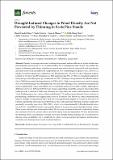Por favor, use este identificador para citar o enlazar a este item:
http://hdl.handle.net/10261/162734COMPARTIR / EXPORTAR:
 SHARE SHARE
 CORE
BASE CORE
BASE
|
|
| Visualizar otros formatos: MARC | Dublin Core | RDF | ORE | MODS | METS | DIDL | DATACITE | |

| Campo DC | Valor | Lengua/Idioma |
|---|---|---|
| dc.contributor.author | Candel-Pérez, David | - |
| dc.contributor.author | Lo, Yueh-Hsin | - |
| dc.contributor.author | Blanco, Juan A. | - |
| dc.contributor.author | Chiu, Chih-Ming | - |
| dc.contributor.author | Camarero, Jesús Julio | - |
| dc.contributor.author | González de Andrés, Ester | - |
| dc.contributor.author | Imbert Rodríguez, Juan B. | - |
| dc.contributor.author | Castillo, Federico J. | - |
| dc.date.accessioned | 2018-03-22T12:46:51Z | - |
| dc.date.available | 2018-03-22T12:46:51Z | - |
| dc.date.issued | 2018-01-02 | - |
| dc.identifier | doi: 10.3390/f9010004 | - |
| dc.identifier.citation | Forests 9 (1): 4 (2018) | - |
| dc.identifier.uri | http://hdl.handle.net/10261/162734 | - |
| dc.description.abstract | Density is an important wood mechanical property and an indicator of xylem architecture and hydraulic conductivity. It can be influenced by forest management and climate. We studied the impact of thinning and climate variables on annual stem radial growth (ring width and ring density, and their earlywood and latewood components) in two contrasting Scots pine (<i>Pinus sylvestris</i> L.) stands in northern Spain (one continental, one Mediterranean). At each site, three thinning regimes (control or T0, removing 20% basal area or T20, and removing 30% or T30) were randomly applied to nine plots per site (three plots per treatment) in 1999. Thinning was repeated at the Mediterranean site in 2009 (increasing thinning intensity in T30 to 40%). Eight trees per plot were cored in spring 2014. Second thinning at the Mediterranean site and first thinning at the continental site generally caused significantly wider ring (RW), earlywood (EW) and latewood (LW) widths, although no differences between T20 and T30/40 were found, supporting in part the common observation that radial growth is enhanced following thinning as competition for water and nutrients is reduced. At the Mediterranean site, values of latewood density (LD) and maximum density (Dmax) relative to pre-thinning conditions were significantly lower in T0 than in T30. However, at the continental site, relative changes of ring density (RD) and LD were significantly higher in T0 than in T20 and T30. Climate significantly affected not only RW but also RD, with significant RD drops during or right after unusually warm-dry years (e.g., 2003, 2011), which were characterized by LD reductions between 5.4 and 8.0%. Such RD decreases were quickly followed by recovery of pre-drought density values. These results indicate trees temporarily reduce LD as a way to enhance hydraulic conductivity during dry summers. However, climate effects on wood density were site-dependent. We also detected that the thinning effect was not intense enough to prevent drought-induced changes in wood density by altering water availability, but it could help to reduce wood properties fluctuations and therefore maintain more homogeneous wood mechanic features. | - |
| dc.description.sponsorship | E.G.A. was funded through a Spanish Predoctoral Research Grant (ref. BES-2013-066705). Funding for this research has been provided by the Spanish Ministry of Economy and Competitiveness (project AGL2012-33465), which also funded Y.-H.L. J.A.B. was funded through a Ramón y Cajal contract (ref. RYC-2011-08082) and a Marie Curie Action (ref CIG-2012-326718-ECOPYREN3), which also funded D.C.-P. Funds to cover the costs of publishing in open access were provided by the OpenAIRE pilot program of the European Union 7th Framework Programme | - |
| dc.publisher | Multidisciplinary Digital Publishing Institute | - |
| dc.relation | info:eu-repo/grantAgreement/MINECO/Plan Estatal de Investigación Científica y Técnica y de Innovación 2013-2016/AGL2012-33465 | - |
| dc.rights | openAccess | - |
| dc.title | Drought-Induced Changes in Wood Density Are Not Prevented by Thinning in Scots Pine Stands | - |
| dc.type | artículo | - |
| dc.identifier.doi | 10.3390/f9010004 | - |
| dc.relation.publisherversion | http://dx.doi.org/10.3390/f9010004 | - |
| dc.identifier.e-issn | 1999-4907 | - |
| dc.date.updated | 2018-03-22T12:46:51Z | - |
| dc.rights.license | http://creativecommons.org/licenses/by/4.0/ | - |
| dc.contributor.funder | Ministerio de Economía y Competitividad (España) | - |
| dc.contributor.funder | European Commission | - |
| dc.contributor.funder | Ministerio de Economía y Competitividad (España) | - |
| dc.relation.csic | Sí | - |
| dc.identifier.funder | http://dx.doi.org/10.13039/501100003329 | es_ES |
| dc.identifier.funder | http://dx.doi.org/10.13039/501100000780 | es_ES |
| dc.type.coar | http://purl.org/coar/resource_type/c_6501 | es_ES |
| item.grantfulltext | open | - |
| item.cerifentitytype | Publications | - |
| item.openairecristype | http://purl.org/coar/resource_type/c_18cf | - |
| item.fulltext | With Fulltext | - |
| item.openairetype | artículo | - |
| Aparece en las colecciones: | (IPE) Artículos | |
Ficheros en este ítem:
| Fichero | Descripción | Tamaño | Formato | |
|---|---|---|---|---|
| forests-09-00004-v3.pdf | 6,94 MB | Adobe PDF |  Visualizar/Abrir |
CORE Recommender
SCOPUSTM
Citations
19
checked on 11-abr-2024
WEB OF SCIENCETM
Citations
18
checked on 29-feb-2024
Page view(s)
360
checked on 15-abr-2024
Download(s)
335
checked on 15-abr-2024
Google ScholarTM
Check
Altmetric
Altmetric
Este item está licenciado bajo una Licencia Creative Commons

